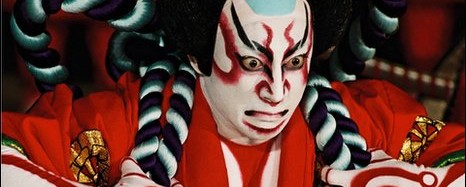
歌舞伎
Kabuki (歌舞伎) is Japanese traditional theater, it’s roots go back to the Edo era. It has been recognized as one of Japan’s three classic theaters, among them are nohe and bunrakun. Kabuki was included in the UNESCO-’s intangible cultural heritage list. Kabuki is a way to bring art to the people. It covers in detail designed clothes, attractive makeup, unusual wigs, and the most important part is the actors exaggerated game. Movements previously thought needs for rendering the to audience the meaning of the performance: it is very important because during the performance used the old Japanese language, which is very difficult to understand even for Japanese. Movable area of stage, rotating platforms and manholes allow unnoticed appear or to disappear actor and rapidly change scene. Kabuki’s stage another feature is the bridge (hanamichi), which runs through the audience, giving a dramatic entrance or exit opportunities. The atmosphere complements with the traditional Japanese instruments live music. Many elements are merged, in order to get a charming and stunning presentation. Scenarios are usually based on historical events, heartbreaking tragedies, love stories, the moral contradictions and other stories. Kabuki’s unique feature of the it is part of which was staged in the presentation only a part of the whole story (basically the best part). Nevertheless, for enlarge the pleasure during the performance recommended at least a little read about the history, which should be in the performance. In some theaters are given the performance’s content and explanation in English. Initially, Kabuki played only women. Later in the Edo era the participation of women was prohibited, and up to date Kabuki theater plays are only men. It’s interesting that there are male actors who specialized in playing only women’s roles. There are also assistants in black dressed who appear on the stage. They help the actors or give the necessary items. Theyare called “kurogo” and are considered non-existent people. There are no special clothes, that will be incurred in Japan going to the theater, however, Japanese women in the first day of performance sometimes wear Kimono.
http://ostarmenia.com/hy/cinema-theatre-arm/kabuki/から取られた材料










